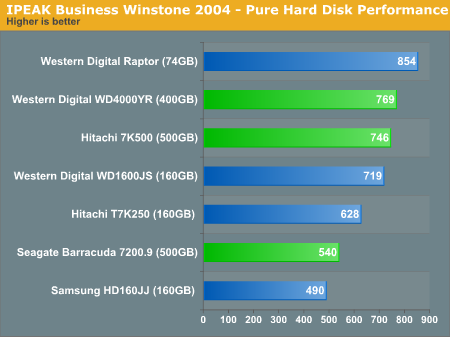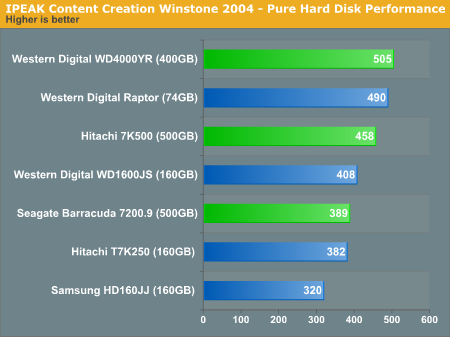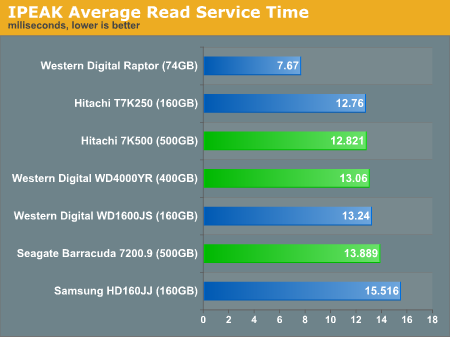Hitachi vs. Western Digital vs. Seagate: A Battle of the Mammoths
by Purav Sanghani on December 2, 2005 12:05 AM EST- Posted in
- Storage
Pure Hard Disk Performance - IPEAK
We begin our usual hard disk drive test session with Intel's IPEAK benchmarking utility. We first run a trace capture on Winstone 2004's Business and Multimedia Content Creation benchmark runs to catch all of the IO operations that take place during each test. We then play back each capture using RankDisk, which reports back to us a mean service time, or average time that the drive takes to complete an IO operation.
Let's take a look at Content Creation performance.
We begin our usual hard disk drive test session with Intel's IPEAK benchmarking utility. We first run a trace capture on Winstone 2004's Business and Multimedia Content Creation benchmark runs to catch all of the IO operations that take place during each test. We then play back each capture using RankDisk, which reports back to us a mean service time, or average time that the drive takes to complete an IO operation.

Let's take a look at Content Creation performance.












46 Comments
View All Comments
Griswold - Friday, December 2, 2005 - link
I can understand mentioning AGP, but PCI? You gotta be kidding me... that bus is such a bottleneck. You dont even have to run PCI cards to find out, just stress all the on-board stuff on a feature rich mobo and you'll notice it too.
Cygni - Friday, December 2, 2005 - link
Which explains the rush from the mfts to get PCI-Ex cards out the door. :p Really, the only 2 cards that i can see benifiting from the PCI Express bus are high level RAID cards and gigabit ethernet... both of which are being fully integrated into southbridges anyway.Hikari - Friday, December 2, 2005 - link
You said AGP and PCI, not AGP and PCIe. Obviously there isn't a lot of difference between the latter, but there is quite a bit of difference between the former.Griswold - Friday, December 2, 2005 - link
They are integrated into southbridge and still utilize the PCI bus mostly. PCI bus aint only the slot you see on your mobo, you know..Anton74 - Friday, December 2, 2005 - link
High level RAID? A single PATA drive has an interface speed identical to that of the PCI bus (133MB/s) these days, all by itself. And then there's SATA with 150MB/s and 300MB/s interface speeds now. Not to mention the PCI bus is usually shared with a multitude of devices, all wanting some bandwidth.puffpio - Friday, December 2, 2005 - link
It seems anomalous that the Western Digital Raptor 10000RPM drive is sooo much slower in the Doom 3 level load test compared to all the other drives. It sticks out like a sore thumb. It doesn't make sense because it had been dominating the other tests...